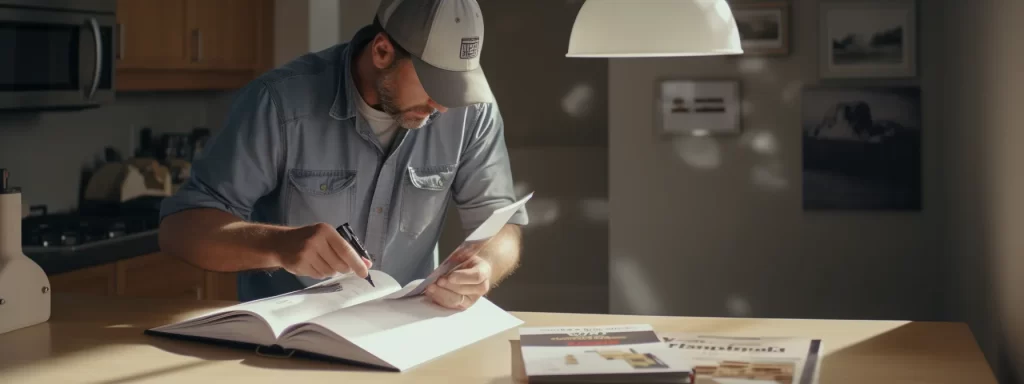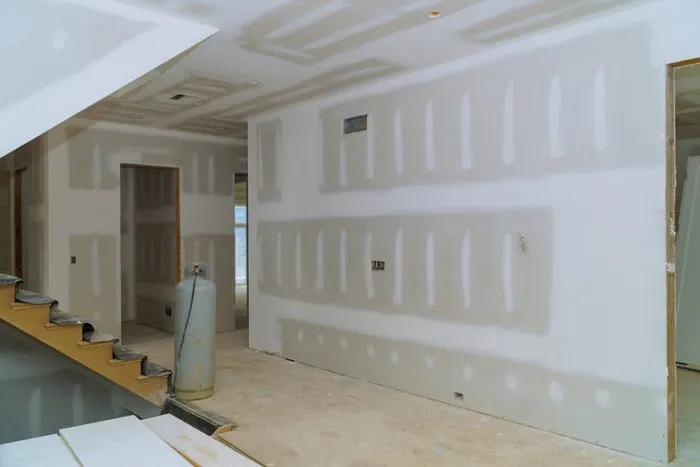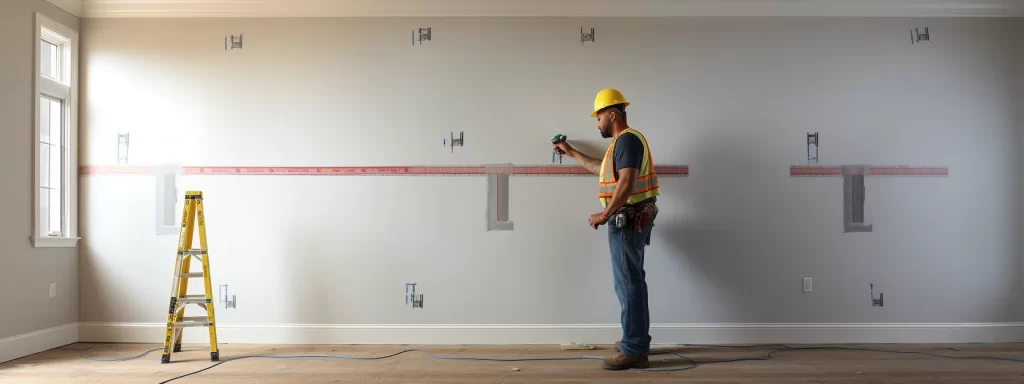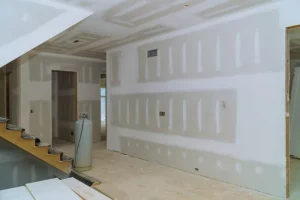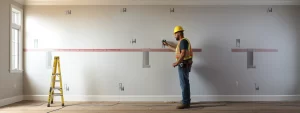
Handling Drywall Mold: A Comprehensive Guide by Leading Drywall Contractors
Mold lurking behind your pristine drywall could be a health hazard and a home improvement nightmare.
From the threat of water damage to unpleasant mold growth and the disturbing mycotoxins, our local drywall business in St Louis understands the unease black mold brings to households.
Armed with expertise as seasoned drywall installers and sheetrock contractors, we bring to you a comprehensive guide on understanding, preventing, and tackling mold on drywalls.
Keep reading to embark on a journey to a safer, mold-free home.
Understanding Mold on Drywall
Grasping the implications surrounding mold on drywall is the first step to managing such issues. As a seasoned drywall contractor in St Louis, I’ve seen my fair share of water damage and mold-related problems in the drywall industry. They mostly occur in high-humidity areas like shower walls and laundry rooms.
The unsightly black mold can be a real household blight and a potential health hazard. Often, it’s the product of water leaks within inside walls, which can go unnoticed for some time. This damage poses a serious risk of leading to the spread of mycotoxins and mold spores.
In assessing mold growth, it’s essential to determine whether it’s surface mold or a more invasive type. The process involves donning rubber gloves, preparing a bleach solution or using household items like baking soda or hydrogen peroxide as a mold cleaner. Our drywall service experts have mastered the art of mold remediation to ensure the safety and health of your family and home.
Drywall repair or replacement comes after successful mold removal. Our drywall installation service utilizes high-quality gypsum board to protect against future moisture damage. This construction project doesn’t negate the importance of preventive measures like a dehumidifier for effective moisture management. Trust in the expertise of leading drywall installers to rectify your mold problem swiftly and safely.
Causes and Signs of Drywall Mold
The causes of drywall mold are myriad, but predominantly they’re linked to a moisture-rich environment. Unaddressed leaks, poor ventilation, or flooding can lead to moisture seeping into the drywall – an optimal condition for mold growth. High humidity spaces like bathrooms and basements often fall prey to such situations.
Typically, mold on sheetrock and other forms of drywall may go unnoticed until the problem becomes more extensive. Early mold signs are usually subtle, like a distinct musty smell that persists or discolored patches on walls and ceiling. Also, the presence of blue mold behind wallpaper or paneling can be a telling sign of a lurking problem.
The undeniable visual sign of drywall mold is black or green spots scattered on the wall surface. Wallpaper or paint peeling off from the drywall is another insightful indicator. Proactive attention to these signs can prevent any significant drywall damage or costly drywall repair in the long run.
It’s prudent for homeowners and homebuyers alike to be aware of these symptoms. Keeping an eye out for possible mold growth is a key component of maintaining a healthy living environment. An EIFS stucco finish could potentially mask a mold problem, but a specialized sheetrock contractor will have the knowledge to identify even the most concealed mold, ensuring customer satisfaction is met.
Strategies to Prevent Drywall Mold
Preventing mold growth on drywall is an essential part of maintaining healthy indoors. Mold can threaten the structural integrity of your home, wreaking havoc on your drywall and potentially creating health hazards over time. As a drywall contractor, I advise homeowners to prioritize mold prevention as part of their home improvement projects.
Preventing mold growth significantly involves controlling the moisture in your living spaces. Waterproofing is key to prevent water from seeping into your drywall and creating a mold-friendly environment. This might involve investing in quality grout, membrane systems for shower walls, and water-resistant drywall for areas prone to moisture.
Investing in soundproofing measures can contribute to mold prevention as well. Acoustical measures offer moisture resistance, and can serve as prudent prevention tactics against mold growth. Also, regular home repair and renovation works as scheduled by a specialty contractor like us can help identify and manage issues at an early stage:
- Regularly check for any visible signs of mold or mildew.
- Conduct routine moisture checks especially in areas prone to water damage.
- Utilize drywall that is resistant to mold.
- Ensure your living spaces are well ventilated and that humid areas have efficient air circulation.
- Address any leaks or water damage immediately to prevent potential mold infestations.
Another important preventive measure is having a cleaning solution ready in case you spot any mold. From household solutions like baking soda and hydrogen peroxide to commercial mold cleaners, having these handy deters the growth of mold. Following these steps can help keep your home mold-free while maintaining the aesthetic appeal of your drywall.
Step-by-Step Guide to Remove Mold on Drywall
Addressing the issue of mold on your drywall promptly is imperative to protect your home and family. As a professional drywall installer, I’ve handled multiple mold remediation cases, where my clients benefited hugely from our methodical approach to mold removal. In this section, I’ll share with you a basic, step-by-step guide to remove mold on drywall.
Remember, safety first. Before starting the mold removal process, gear up in appropriate protective equipment including rubber gloves, safety goggles, and a HEPA mask. Mold spores might get disbursed into the air during cleaning and these precautions protect you from inhaling the dangerous mycotoxins.
Here’s an overview of the basic process for removing mold from your drywall surfaces:
- Set-up a containment area with plastic sheets to prevent mold spores from spreading to other parts of the house.
- Prepare your mold cleaner. For mild mold, a simple solution of borax and water might suffice. For harsher mold, you may need a bleach solution or a commercial mold cleaner.
- Sponge or spray the solution directly on the moldy area.
- Use a scrub brush to scrub away the mold off the drywall surface. Be gentle to avoid damaging the drywall.
- Once done, let it sit for at least ten minutes, then wipe the area clean. Employ a dehumidifier to dry the area thoroughly.
This process should help remove surface mold on your drywall. However, if the mold problem persists or if the drywall shows signs of notable water damage, it’s better to call for professional help. As a skilled drywall repair service provider, we ensure immediate action and longer-lasting results to take your mold worries away.
Hiring a Professional Drywall Contractor: Things to Consider
When facing a persistent mold problem or a substantial drywall project, employing an experienced drywall contractor is a wise decision. The task requires certain skills and expertise that only a skilled professional can provide. This can take the burden off your shoulders and ensure the longevity of your home improvement project.
The first thing to consider when hiring a professional is their area of expertise. Choose a contractor who specializes in drywall works, ideally one with experience in mold remediation. Such a specialty contractor can offer a broad range of services, from managing initial mold problems to performing complex drywall repairs and installations.
Customer service is another essential factor. A good drywall company fosters a professional relationship with their clients, providing clear and open communication about the project’s progress. Look for contractors known for their promptness, efficiency, and top-notch customer service. These are fundamental traits that highlight a strong dedication to customer satisfaction.
Lastly, affordability matters. You should always consider drywall installation cost. Look for contractors who offer competitive rates without compromising the quality of work delivered. The best drywall companies ensure their services are worth every penny, making your home a safer and more comfortable space to live in.
Drywall Repair and Maintenance After Mold Removal
Post mold removal, the next crucial step is repair and maintenance of your drywall. Having dealt with multiple drywall projects, I can’t stress enough how essential proper maintenance is in prolonging the lifespan of your drywall. A good routine protects your walls from future mold problems and water damage.
Repairing damaged drywall surfaces involves multiple stages including application of drywall mud and joint compound. Then comes the sanding and painting processes to restore the wall to its original condition. The benefit of hiring a professional drywall service is getting a well-executed repair that’s hard to differentiate from an intact, undamaged wall.
Occasionally, for extensive mold infestations, you might face scenarios where drywall replacement becomes necessary. This process involves removing damaged sections and installing new drywall pieces. Knowledgeable installers at our drywall company understand the intricate details of matching the new material with the existing one for seamless continuity.
Maintenance of drywall post mold removal majorly revolves around effective moisture management. Emphasis on regular checks for any potential water leaks, use of a dehumidifier during humid seasons, and ensuring adequate ventilation can significantly reduce the risk of future mold complications. As part of my commitment to customer service, I always advise my clients on how to protect their homes from recurrent mold challenges.
Frequently Asked Questions
How to get rid of mold on drywall?
Mold growth on drywall can be a health hazard and can also cause damage to the structure of your home if left untreated. Fortunately, there are steps you can take to effectively get rid of mold on drywall. First, it is important to ensure that you are wearing protective gear such as gloves, goggles, and a mask to prevent inhalation of mold spores. Next, it is crucial to identify the source of the moisture that is causing the mold growth and fix it to prevent further issues. Once the source is fixed, you can proceed to tackle the mold. Start by using a stiff brush or sponge to scrub off as much of the mold as possible. Be careful not to scrub too hard as you may damage the drywall. Afterward, prepare a solution of water and detergent or a commercial mold cleaner and use a sponge or cloth to thoroughly clean the affected area. Ensure that you cover the entire surface and remove all traces of mold. If the mold has penetrated the drywall extensively, it may be necessary to remove and replace the affected sections. However, for smaller areas, you can use a mold-killing primer to treat the drywall and prevent future mold growth. Finally, it is essential to keep the area dry and well-ventilated to discourage mold from reoccurring. Regularly inspect the drywall for any signs of moisture or mold and address the issue promptly if it arises. With these steps, you can effectively eliminate mold on drywall and create a healthier living environment in your home.
What kills mold on drywall?
Mold growth on drywall can be a common issue in homes and buildings, posing health risks and compromising the structural integrity of the walls. If you’re dealing with mold on drywall, it’s essential to take immediate action to eliminate it. One of the most effective ways to kill mold on drywall is by using a solution of bleach and water. Mix one part bleach with three parts of water, and then spray or apply the mixture directly onto the affected area. Allow it to sit for about 15 minutes, ensuring the mold is thoroughly saturated. Afterward, scrub the area with a brush or sponge to remove any remaining mold. It’s important to use proper safety precautions, such as wearing protective gloves and a face mask, as bleach can release harsh fumes. Once you’ve removed the mold, make sure to thoroughly dry the affected area to prevent future mold growth. Additionally, addressing the underlying cause of the moisture, such as fixing leaks or improving ventilation, is crucial to prevent mold from recurring. When dealing with extensive mold growth or if you’re unsure about how to handle the situation, it’s advisable to consult with a professional mold remediation company to ensure proper and safe removal of mold from drywall.
Can you remove mold from drywall?
Yes, it is possible to remove mold from drywall. However, it is important to note that the removal process can be challenging and should be done with caution. Before starting the removal process, it is recommended to wear protective clothing, such as gloves and goggles, to prevent any exposure to mold spores. To remove mold from drywall, you can follow a step-by-step process. First, identify the areas affected by mold growth. This can often be seen as dark spots or discoloration on the drywall surface. Next, ensure proper ventilation in the area by opening windows or using fans to prevent the spread of mold spores. Before cleaning the affected area, it is essential to address the source of moisture or water leakage that has caused the mold growth. Repair any plumbing issues, fix leaks, or improve ventilation to prevent future mold problems. To remove the mold from the drywall, scrub the affected area using a mixture of water and detergent. Use a scrub brush or sponge to gently scrub the mold off the surface. Avoid using bleach, as it may discolor the drywall. In some cases, using a mildew-resistant paint primer or a fungicide may be necessary to treat the mold-infested area. It is important to note that if the mold growth covers a large area or extends beyond the surface of the drywall, it might be necessary to remove and replace the affected drywall entirely. This is particularly true if there is extensive damage or if the drywall has become weakened due to water exposure. In such cases, it is recommended to seek professional help to ensure proper removal and replacement. To prevent further mold growth, it is crucial to address and fix any underlying moisture issues. Regularly inspect and maintain areas prone to dampness, such as bathrooms, basements, or areas affected by water leaks. Keeping the indoor humidity levels low, using dehumidifiers, and ensuring proper ventilation can also help in preventing mold growth on drywall surfaces.
Can you kill mold on drywall?
Mold is a common problem in many homes, especially on drywall surfaces. Not only is mold unsightly, but it can also pose health risks if left untreated. So, can you kill mold on drywall? The answer is yes, but it requires a thorough and methodical approach. First, it’s important to identify the source of the mold growth and fix any underlying issues that are causing it, such as a leaky pipe or high humidity levels. Once the source is addressed, you can move on to removing the mold. Begin by protecting yourself with gloves, goggles, and a mask, as mold spores can be harmful when inhaled. Next, equip yourself with cleaning supplies specifically designed to kill mold, such as a mixture of bleach and water or a commercial mold remover. Apply the solution to the affected areas and scrub gently with a brush to remove the mold. Be sure to take it slow and avoid damaging the drywall. After cleaning, use a wet-dry vacuum or sponge to remove any excess moisture. Finally, allow the area to dry completely and monitor it closely to ensure that the mold does not return. Keep in mind that if the mold growth is extensive or recurring, it may be necessary to seek professional help to address the issue effectively.
Conclusion
In conclusion, proper handling of drywall mold is indeed crucial for any homeowner.
Mold on drywall can not only mar the aesthetics of your home, but it can also pose potential health hazards.
From understanding the causes and signs of drywall mold to preventing its growth and effectively removing it, every step plays an integral role in maintaining a safe and healthy living environment.
It’s important to remember, when it comes to extensive mold problems or drywall projects, seeking professional help from an experienced drywall contractor can be a game-changer.
They provide expertise, customer service, and the commitment to safety and satisfaction that can make your home mold-free and comfortable.
